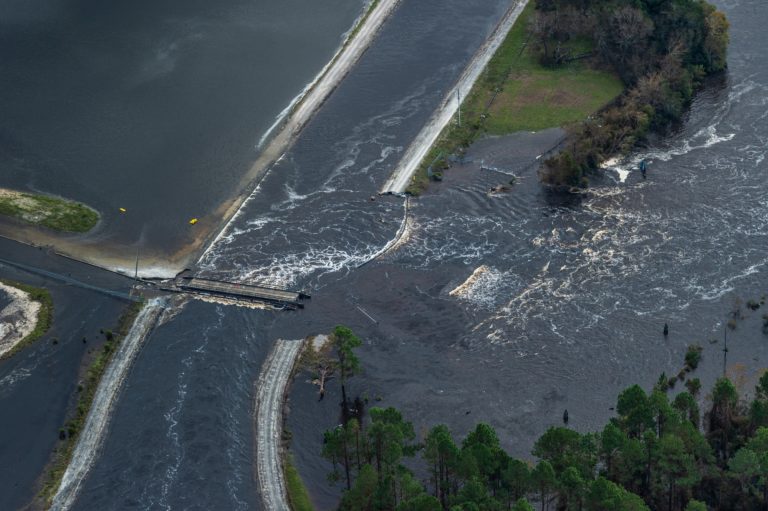Waterkeeper Calls for Stricter Coal Ash Storage Regulations in the Wake of North Carolina Spills
By: Waterkeeper Alliance

As the massive coal ash spill at Duke Energy’s L.V. Sutton Power Plant contaminates the still-rising Cape Fear River, Waterkeeper Alliance is calling for more stringent national and state regulations on coal ash, the top source of toxic water pollution in the country.
“What concerns me most is that the Cape Fear River is projected to rise 4 more feet and make conditions much worse at the Sutton facility in the next 48 hours,” said Kemp Burdette, Cape Fear Riverkeeper. “The Cape Fear River is already flooded with millions of gallons of hog waste and other sources of pollution. Added to that are now untold amounts of coal ash actively spilling every hour from the Sutton coal ash ponds. There is an urgent need for both hog lagoons and coal ash ponds to be removed from the flood-prone areas near our rivers and lakes before the next climate change fueled superstorm hits us,” Burdette concluded.
“The breaches of the dry coal ash landfill at Sutton, which swallowed a bulldozer and a tractor, show us that not only are wet ash ponds a danger but so are landfills,” said Donna Lisenby, global advocacy manager at Waterkeeper Alliance.
“Cleaning up tons of toxic coal ash needs to be a much higher priority because we don’t need yet another lake or river flooded with tons of this toxic mess,” Lisenby said. “Pits full of coal ash have no place on a floodplain. Now that the Emory, Dan and Cape Fear rivers have suffered from these spills, it is past time for all utilities in the United States, especially Duke Energy, to remove this threat from our waterways.”
Waterkeeper Alliance staff and local Waterkeeper Organizations have been monitoring the coal ash landfill and ponds at the Sutton plant by plane, truck, and motorboat. They are collecting water samples to send to a state-certified lab to test for heavy metals and other toxins. Their photos and video are available here.
Duke Energy’s H.F. Lee site near Goldsboro, N.C. also had a coal ash spill in the wake of Hurricane Florence. Waterkeeper Alliance staff, along with Upper Neuse Riverkeeper Matt Starr, French Broad Riverkeeper Hartwell Carson, and Haw Riverkeeper Emily Sutton documented multiple coal ash releases from the H.F. Lee facility on September 19.
“The spill at H.F. Lee was completely predictable and entirely preventable,” said Starr. “Duke continues to mislead the public about the threat posed by their coal ash storage, but two years after its coal ash spill during Hurricane Matthew, it is infuriating that we still are talking about those same ponds at Lee being under water again—without one shovelful of coal ash being moved.”
Hurricane Matthew in 2016 showed the vulnerability of Duke facilities to severe weather. But even normal rainfalls have led to spills: Duke blamed an October 2017 spill in Cliffside on 3.74 inches of rain. Another release from the Asheville airport structural fill in October 2017 was caused by what Duke called “severe thunderstorms.”
Duke Energy owns 32 coal ash basins in North Carolina, all of which are either adjacent to or within a half mile of a river or lake. The coal ponds contained about 111 million tons of toxic coal ash as of August 2017, according to state estimates. Coal ash contains toxic heavy metals such as arsenic, chromium, and mercury.
Waterkeeper Alliance reviewed EPA records of historical waste releases from coal ash ponds in North Carolina. Among them: A breach of an internal pond dike at the W.H. Weatherspoon Power Station in 2001; flooding that washed away waste at Cliffside Steam Station in 2005; and a pond breach at the Roxboro Power Station in 2008. On September 28, 2010, a coal ash pond dam failed at Sutton. Employees found the failure when they drove a truck into the breach. Approximately 10 cubic yards of coal ash was released from the breach estimated to be approximately eight feet deep and about 22 feet wide by 100 feet long. Photos of the 2010 breach at Sutton can be found here.
The Waterkeeper Alliance Rapid Response initiative provides trusted and independent information following disasters on our waterways. In a climate of lax federal regulations and budget cuts to state departments of environmental conservation, the need for Waterkeeper Organizations and Waterkeeper Affiliates to speak truth about the devastating impacts of water emergencies on communities has never been greater. Waterkeeper groups will remain involved as long as necessary in order to assure that proper clean-up, mitigation, and enforcement is completed.
**Photo by Jo-Anne McArthur